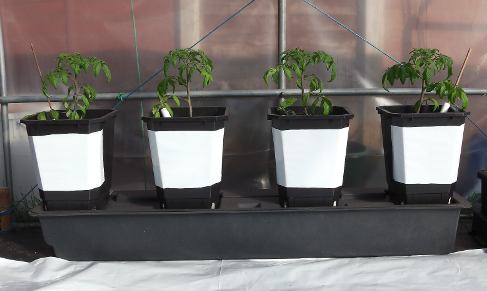There is nothing better than the sun for helping tomato plants to grow
The sun helps plants make their own food in the form of sugars (photosynthesis).
The sugars, stored in the leaves, are then combined with oxygen to create energy for growth (respiration).
It doesn’t matter…
- How much plant food we give our tomato plants,
- How much we water them,
- How good the soil is,
Even with the right temperatures – without the sun, or the right kind of light, our plants won’t grow.
But can tomato plants have too much of a good thing?
They cannot have too much natural light but they can have too much heat especially in the greenhouse.
Temperatures over 35C can cause plants to stop growing. High temperatures combined with direct sunlight can cause leaves to turn away from the light – either by cupping or rolling.
Wilting is also common problem when plants run low on water – water escapes through the leaves faster than it can be drawn up through the roots (transpiration).
Longer periods of direct sunlight on the fruit, plus high temperatures can cause sunscold, where tomatoes have yellow patches, because they are unable to create lycopene – the red pigment in the flesh and the skin.
When the air is also dry and low in humidity, flowers can fail to set.
Whenever plants display a problem caused by too much or too little of something, it is called stress.
- Heat stress
- Water stress
- Nutrient stress
- Disease stress
So when the weather is very warm or hot for several days, how do we help our plants through potential heat stress?
Plenty of aeration in the greenhouse plus shading with garden fleece (or similar such as windolene) to reduce temperatures.
When plants are shaded, water can be sprayed on the leaves to reduce heat from plants – useful in conjunction with good air flow.
Pour a bucket of water over the greenhouse floor if air is very dry.
Cover all dark surfaces such as black pots with white paper or plastic.

Flowers can be misted with water and agitated to help set fruit – especially before midday.
A reservoir watering system is best – see Oasesbox and Quadgrow Planter, or use a tap timer and pipe watering system and water at least twice each day.
In hot weather, the smaller the container you use for your plants, the more often you’ll need to water them in order to avoid stress.
Feeding in hot weather
Little and often is always the best way to feed, especially in hot weather.
If in doubt, it’s best not to feed at all rather than too much, because plants absorb water more quickly when there are no nutrients
in the solution.
If the lowest leaf branch or two looks a bit underfed or poorly, it/they can be removed.
Later in the season, it’s good to remove certain leaf branches in order to reduce the amount of water plants need and encourage fruiting. More about pruning and feeding as we go through the season.
GDPR Email
If you are on my Newsletter email list, you probably received an email on Thursday asking you to re-confirm your first name and email.
If you would like to continue to receive the Saturday email and link to the Newsletter, please check the email box, after clicking the link in Thursday’s email, and click update settings. Thank you if you have done so already.
If you do not wish to receive emails from me, please unsubscribe. You can still view the Newsletters at this link:
https://www.tomatogrowing.co.uk/newsletter/ which you could bookmark.
That’s it for another week … it has been very warm in my part of the world. The amazing thing about the weather here in the UK is that we never know what’s coming next – sometimes it seems like all four seasons in one day!
Regards,
Nick

Leave a Reply